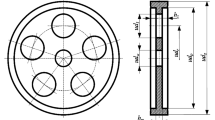Abstract
Based on the micromorphic theory (MMT), the vibrational behavior of annular sector plates with different angles and subjected to various boundary conditions (BCs) is studied. To this end, the linear formulation of three-dimensional (3D) MMT is first presented and the matrix representation of this formulation is given. Then, a 3D size-dependent 8-node brick element is developed by the user element (UEL) subroutine within the commercial finite element software Abaqus to investigate the effects of microstructures on the vibration response of micromorphic structures. The effects of thickness-to-length scale parameter ratio and sector angle on the vibration behavior of the micromorphic annular sector plates are studied. Also, the results obtained by MMT are compared to those of the classical elasticity theory.









Similar content being viewed by others
References
Ma, Q., Clarke, D.R.: Size-dependent hardness of silver single crystals. J. Mater. Res. 10, 853–863 (1995)
Zhu, H.T., Zbib, H.M., Aifantis, E.C.: Strain gradients and continuum modeling of size effect in metal matrix composites. Acta. Mech. 121, 165–176 (1995)
Stolken, J.S., Evans, A.G.: A micro-bend test method for measuring the plasticity length scale. Acta. Metall. Mater. 46, 5109–5115 (1998)
McElhancy, K.W., Valsssak, J.J., Nix, W.D.: Determination of indenter tip geometry and indentation contact area for depth sensing indentation experiments. J. Mater. Res. 13, 1300–1306 (1998)
Taylor, M.B., Zbib, H.M., Khaleel, M.A.: Damage and size effect during superplastic deformation. Int. J. Plast. 18, 415–442 (2002)
Mindlin, R.D.: Micro-structure in linear elasticity. Arch. Ration. Mech. Anal. 16, 51–78 (1964)
Mindlin, R.D.: Second gradient of strain and surface tension in linear elasticity. Int. J. Solids Struct. 1, 417–438 (1965)
Eringen, A.C.: On differential equations of nonlocal elasticity and solutions of screw dislocation and surface waves. J. Appl. Phys. 54, 4703–4710 (1983)
Eringen, A.C., Wegner, J.L.: Nonlocal continuum field theories. Appl. Mech. Rev. 56(2), B20–B22 (2003)
Toupin, R.A.: Elastic materials with couple stresses. Arch. Ration. Mech. Anal. 11, 385–414 (1962)
Mindlin, R.D., Tiersten, H.F.: Effects of couple-stresses in linear elasticity. Arch. Ration. Mech. Anal. 11, 415–448 (1962)
Koiter, W.T.: “Couple stresses in the theory of elasticity”. In: i and II, Proc. K. Ned. Akad. Wet. (B) 67, 17–44, (1964)
Eringen, A.C., Suhubi, E.S.: Nonlinear theory of simple micro-elastic solids–I. Int. J. Eng. Sci. 2, 189–203 (1964)
Suhubi, E., Eringen, A.C.: Nonlinear theory of micro-elastic solids- II. Internat. J. Engng. Sci. 2, 389–404 (1964)
Eringen, A.C.: Theory of micropolar plates. Z. Angew. Math. Phys. 18, 12–30 (1967)
Eringen, A.C.: Theory of micropolar elasticity. Fract. Adv. Treat. 2, 621–728 (1968)
Eringen, A.C.: Microcontinuum Field Theories I, Foundations and Solids. Springer, NewYork (1999)
Eringen, A.C.: Theory of thermo-microstretch elastic solids. J. Eng. Sci. 28, 1291–1301 (1990)
Pasternak, E., Mühlhaus, H.B.: Generalized homogenization procedures for granular materials. J. Eng. Math. 52, 199–229 (2005)
Oliver, J., Mora, D.F., Huespe, A.E., Weyler, R.: A micromorphic model for steel fiber reinforced concrete. Int. J. Solids Struct. 49, 2990–3007 (2012)
Cao, W., Yang, X., Tian, X.: Anti-plane problems of piezoelectric material with a micro-void or micro-inclusion based on micromorphic electroelastic theory. Int. J. Solids Struct. 49, 3185–3200 (2012)
Cao, W.Z., Yang, X.H., Tian, X.B.: Numerical evaluation of size effect in piezoelectric micro-beam with linear micromorphic electroelastic theory. J. Mech. 30, 467–476 (2014)
Lee, J.D., Wang, X.: Generalized micromorphic solids and fluids. Int. J.Eng.Sci. 49(12), 1378–1387 (2011)
Sansour, C., Skatulla, C., Zbib, H.: A formulation for the micromorphic continuum at finite inelastic strains. Int. J. Solids Struct. 47, 1546–1554 (2010)
Dillard, T., Forest, S., Ienny, P.: Micromorphic continuum modelling of the deformation and fracture behavior of nickel foams. Eur J Mech A Solids 25, 526–549 (2006)
Neff, P., Forest, S.: A Geometrically exact micromorphic model for elastic metallic foams accounting for affine microstructure, Modelling, existence of minimizers, identification of moduli and computational results. J. Elast. 87, 239–276 (2007)
Li, J., Robert, K.P., Lee, J.D.: Micromorphic theory and its finite element formulation. Acta. Mech. 231, 1253–1284 (2020)
Isbuga, V., Regueiro, R.A.: Three-dimensional finite element analysis of finite deformation micromorphic linear isotropic elasticity. Int. J. Eng. Sci. 49, 1326–1336 (2011)
Ansari, R., Bazdid-Vahdati, M., Shakouri, A.H., et al.: Micromorphic prism element. Math. Mech. Solids. 22, 1438–1461 (2016)
Eremeyev, V.A., Lebedev, L.P., Cloud, M.J.: Acceleration waves in the nonlinear micromorphic continuum. Mech. Res. Commun. 93, 70–74 (2018)
Ansari, R., Bazdid-Vahdati, M., Shakouri, A.H., Norouzzadeh, A., Rouhi, H.: Micromorphic first-order shear deformable plate element. Meccanica 51, 1797–1809 (2016)
Isbuga, V., Regueiro, R.A.: Finite element analysis of finite strain micromorphic Drucker-Prager plasticity. Comput. Struct. 193, 31–43 (2017)
Ansari, R., Norouzzadeh, A., Shakouri, A.H., Bazdid-Vahdati, M., Rouhi, H.: Finite element analysis of vibrating microbeams and -plates using a three dimensional micropolar element. Thin-Walled Struct. 124, 489–500 (2018)
Faraji-Oskouie, M., Bazdid-Vahdati, M., Ansari, R., Rouhi, H.: Finite element modeling of micromorphic continua in the context of three-dimensional elasticity. Contin.Mech. Thermodyn. 32, 99–110 (2020)
Shaat, M., Ghavanloo, E., Emam, S.: A micromorphic beam theory for beams with elongated microstructures. Sci. Rep. 10(1), 1–18 (2020)
Kohansal-Vajargah, M., Ansari, R.: Quadratic tetrahedral micropolar element for the vibration analysis of three-dimensional micro-structures. Thin-Walled Struct. 167, 108152 (2021)
Kohansal-Vajargah, M., Ansari, R., Faraji-Oskouie, M., Bazdid-Vahdati, M.: Vibration analysis of two-dimensional structures using micropolar elements. Appl. Math. Mech. 42, 999–1012 (2021)
Abaqus/Standard Analysis User’s Manual, SIMULIA, (2012)
Kumar. N., Leibinz. J.: Visualization of User Element in Abaqus. University Hannover, Germany (2016)
Lakes, R.: Experimental microelasticity of two porous solids. Int. J. Solids Struct. 22, 55–63 (1986)
Author information
Authors and Affiliations
Corresponding author
Additional information
Publisher's Note
Springer Nature remains neutral with regard to jurisdictional claims in published maps and institutional affiliations.
Appendices
Appendix A
Appendix B
Rights and permissions
About this article
Cite this article
Ansari, R., Vajargah, M.K. & Bakamal, A. Vibration study of micromorphic annular sector plates using a 3D finite element analysis. Acta Mech 233, 3663–3677 (2022). https://doi.org/10.1007/s00707-022-03281-9
Received:
Revised:
Accepted:
Published:
Issue Date:
DOI: https://doi.org/10.1007/s00707-022-03281-9




